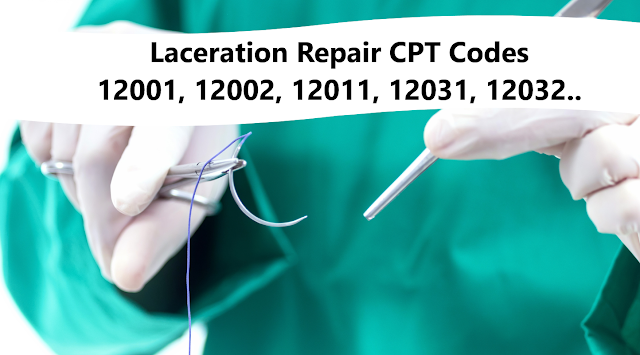CPT guidelines state that when a provider closes a wound with sutures, staples, or tissue adhesives—either alone, in combination with one another, or in addition to adhesive strips—laceration repair codes should be reported. Furthermore, whether the repair is curved, angular, or stellate (star-shaped), it must be measured and documented in centimetres in accordance with CPT.
Laceration Repair CPT Codes
The CPT Manual divides laceration repairs into three categories:
- Simple repair (CPT codes 12001 – 12021)
- Intermediate repair (CPT codes 12031 – 12057)
- Complex repair (CPT codes 13100 – 13160)
Simple Repairs
Simple repair is implemented when a wound only needs a one-layer closure and is superficial (primarily involving the epidermis, dermis, or subcutaneous tissues with minimal involvement of deeper structures).
All local anaesthesia, as well as chemical or electrocauterization of open wounds, are included in the simple repair codes. The codes are further classified based on the anatomical location and length of the repair.
- 12001: Simple/Superficial -- Scalp, Neck, Axillae, External Genitalia, Trunk, Extremities with 2.5 cm or less
- 12002: 2.6 cm to 7.5 cm
- 12004: 7.6 cm to 12.5 cm
- 12005: 12.6 cm to 20.0 cm
- 12006: 20.1 cm to 30.0 cm
- 12007: over 30.0 cm
- 12011: Simple/Superficial -- Face, Ears, Eyelids, Nose, Lips, Mucous Membranes with 2.5 cm or less
- 12013: 2.6 cm to 5.0 cm
- 12014: 5.1 cm to 7.5 cm
- 12015: 7.6 cm to 12.5 cm
- 12016: 12.6 cm to 20.0 cm
- 12017: 20.1 cm to 30.0 cm
- 12018: over 30.0 cm
- 12020: Treatment of superficial wound dehiscence: simple closure
- 12021: Treatment of superficial wound dehiscence: with packing
Intermediate Repairs
In addition to the skin (epidermal and dermal) closure, intermediate repair requires one layered closure of one or more of the deeper layers of subcutaneous tissue and superficial (non-muscle) fascia.
Intermediate repair codes also apply to a single-layer closure of heavily contaminated wounds that require extensive cleaning or removal of particulate matter.
- 12031: Intermediate/Layered Closure -- Scalp, Axillae, Trunk, Extremities with 2.5 cm or less
- 12032: 2.6 cm to 7.5 cm
- 12034: 7.6 cm to 12.5 cm
- 12035: 12.6 cm to 20.0 cm
- 12036: 20.1 cm to 30.0 cm
- 12037: over 30.0 cm
- 12041: Intermediate/Layered Closure -- Neck, Hands, Feet, External Genitali
- 12042: 2.6 cm to 7.5 cm
- 12044: 7.6 cm to 12.5 cm
- 12045: 12.6 cm to 20.0 cm
- 12046: 20.1 cm to 30.0 cm
- 12047: over 30.0 cm
- 12051: Intermediate/Layered Closure -- Face, Ears, Eyelids, Lips, Mucous Membranes with 2.5 cm or less
- 12052: 2.6 cm to 5 cm
- 12053: 5.1 cm to 7.5 cm
- 12054: 7.6 cm to 12.5 cm
- 12055: 12.6 cm to 20.0 cm
- 12056: 20.1 cm to 30.0 cm
- 12057: over 30.0 cm
Complex Repairs
Complex repairs require more than layered closure, scar revision, debridement (e.g., traumatic lacerations or avulsions), extensive undermining, stents, or retention sutures. Preparation may include the creation of a limited defect for repairs or the debridement of complicated lacerations or avulsions.
- 13100: Complex Repair – Trunk with 1.1 cm to 2.5 cm
- 13101: 2.6 cm to 7.5 cm
- 13102: each additional 5 cm or less (List separately in addition to code for primary procedure)
- 13120: Complex Repair – Scalp, arms, legs with 1.1 cm to 2.5 cm
- 13121: 2.6 cm to 7.5 cm
- 13122: each additional 5 cm or less (List separately in addition to code for primary procedure)
- 13131: Complex Repair – Forehead, cheeks, chin, mouth, neck, axillae, genitalia, hands, feet with 1.1 cm to 2.5 cm
- 13132: 2.6 cm to 7.5 cm
- 13133: each additional 5 cm or less (List separately in addition to code for primary procedure)
- 13150: Complex Repair – eyelids, nose, ears, lips with 1.0 cm or less
- 13151: 1.1 cm to 2.5 cm
- 13152: 2.6 cm to 7.5 cm
- 13153: each additional 5 cm or less (List separately in addition to code for primary procedure)
- 13160: Secondary closure of surgical wound or dehiscence, extensive or complicated
Coding Multiple Laceration Repairs
When a provider repairs multiple lacerations, coders must add together the lengths of repairs that fall under the same classification and anatomic sites (meaning those that are grouped together under the same general heading in the code descriptors). Do not combine lengths or repairs from different anatomical site groups or classifications.
CPT guidelines state that when a provider repairs more than one type of wound, coders should list the more complicated procedure as primary, the less complicated procedure as secondary, and append modifier -51 (Multiple procedures) to the secondary code.
Most of the time, coders are unable to identify the type of repair performed, so clear documentation is essential. Hopefully, you now understand the fundamentals of Laceration Repairs CPT Codes. Continue reading for more information on CPT codes.


Post a Comment
Webmaster reserves the rights to edit/remove comments that is found irrelevant, offensive, contain profanity, serves as spam or attempts to harbor irrelevant links. Please read our Comments Policy for details.
Click to see the code!
To insert emoticon you must added at least one space before the code.